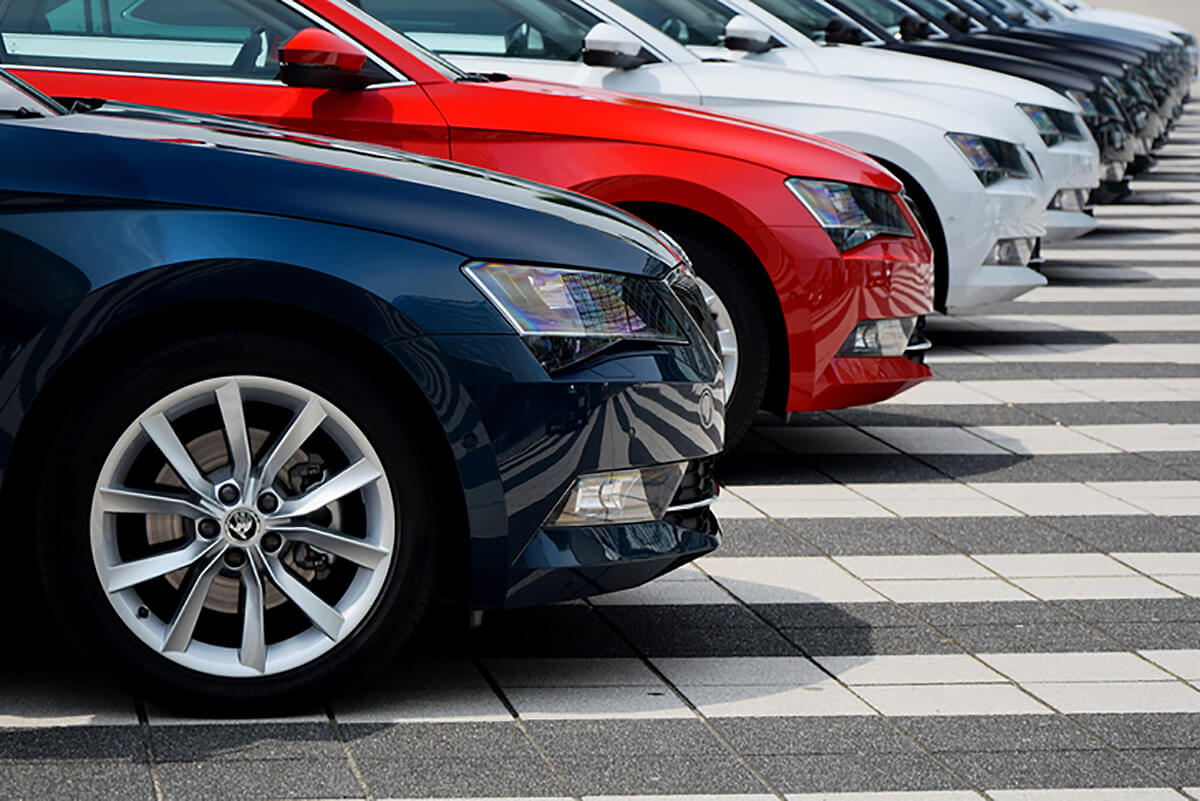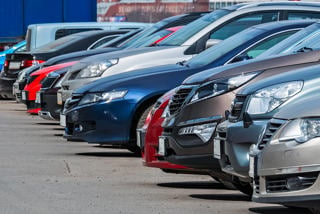The Treasury saw an 18% year-on-year decline in the amount of tax it collected from company cars during the pandemic, new figures published by HMRC show.
Benefit-in-kind (BIK) tax, paid by company car drivers, and national insurance contributions (NICs), paid by employers, fell by £450 million, from £2.51 billion to £2.06bn in 2020/21.
It was the lowest tax take from company cars for almost a decade when, in 2014/15, BIK and NICs were worth £1.9bn to the Government.
The fall in revenue corresponds to a 10% drop in the number of company cars on UK roads over the same period.
The HMRC data shows that there were 720,000 company car drivers in 2020/21 – 80,000 fewer than the 800,000 reported the previous year. That’s despite a zero percentage BIK rate for electric vehicles (EVs) being introduced from April 2020.
The number of company cars has now fallen each year since 2015/16, when HMRC reported that 960,000 employees were receiving the benefit.
In 2016/17, the company car parc fell to 940,000, before dropping to 900,000 vehicles in 2017/18, 870,000 in 2018/19 and 800,000 in 2019/20.
COVID IMPACT ON NUMBERS
With the overall number of drivers falling dramatically, the taxable value of the UK’s company car fleet fell year-on-year.
In 2020/21, the taxable value was £4.62bn, £810m less than the £5.43bn reported by HMRC the previous year, and the lowest it has been since 2016/17, when it was £4.57bn.
From 2011/12 to 2019/20, the total taxable value of reported company cars had increased by almost £2bn from £3.61bn.
HMRC explains that the increase up to 2019/20 was primarily due to increases in the ‘appropriate percentages’ used to calculate the taxable value of a company car, and, to a lesser extent, increases in the average car list price. These offset the falling number of company car drivers.
Meanwhile, the decrease in total taxable value seen in these latest figures, it says, was driven by a reduction in the number of company cars and a shift towards electric-powered cars.
HMRC also contends that company car popularity will have been impacted by travel restrictions implemented during the Covid-19 pandemic.
With the decline in company cars, national insurance paid by employers for providing the benefit, also fell, with HMRC collecting £640m compared with £750m the previous year. It was also the lowest level of NICs collected since 2016/17.
Toby Poston, director of corporate affairs at trade body British Vehicle Rental and Leasing Association (BVRLA), believes the decline was sparked by company car tax rates previously being pushed too high.
“The Government has created a big decline in BIK revenue by taxing drivers out of their cars,” Poston told Fleet News. “They must now avoid repeating that mistake by raising rates on electric company cars by too much, too quickly.
“Lost company car tax revenues will only be recovered by growing the total company car parc, not by over-taxing it and pushing people into non-revenue-generating alternatives such as grey fleet.”
With the introduction of voluntary payrolling in 2016, HMRC says there is evidence to suggest that a “substantial number” of company car benefits were not “correctly reported” in recent tax years, which suggests that the 720,000 figure “underestimates the true number of company car recipients”.
This evidence, it explains, includes both identifying pay-as-you-earn (PAYE) schemes, which registered to payroll company car benefits and yet did not report any company cars through Real Time Information (RTI), and observing unusual trends in the number of company cars reported by PAYE schemes, which do not seem likely to reflect real changes in the provision of company cars to employees.
HMRC says it is not possible to precisely quantify the impact of payrolling on the figures provided, but it believes there is a “reporting gap” that has likely exaggerated the decline seen in recent years.
Many believe that, whatever the true size of the decline, company car numbers have now reached their nadir and, thanks to low BIK rates for electric cars, they are predicted to rise in subsequent years.
SALARY SACRIFICE GROWTH
Paulo Larkman, head of fleet consultancy at Novuna Vehicle Solutions, says the cost savings of opting for an electric company car, particularly through salary sacrifice, is now starting to be more widely understood by employees.
“The (company car) figure for 2020/21 is probably as low as it’s going to go,” he added. “Our order bank is very healthy, and the cash-takers are coming back into schemes.”
Paul Hollick, chair of Association of Fleet Professionals (AFP), also believes company car growth will come through salary sacrifice.
He said: “You just have to look at people like Tusker with its recent announcement it’d launched more than 300 schemes this year.
“I don’t know a member (of the AFP) that either doesn’t already have a salary sacrifice scheme or isn’t in the process of launching one. It’s such a great benefit. It’s a no-brainer.”
With a risk fleet in excess of 21,000 vehicles, Tusker says that more than 50% are now fully electric, while almost 80% of its order bank is for pure EVs.
“Benefit-in-kind rates really drive electric,” said Paul Gilshan, Tusker CEO.
HMRC figures show that pure electric company cars grew 13-fold, from 4,000 EVs in 2019/20, to 54,000 the following year, after the Government introduced the zero-percentage rate for EVs.

FIRST-TIME COMPANY CAR DRIVERS
Tusker is seeing “huge growth” in its salary sacrifice product. “The vast majority of our salary sacrifice drivers are also opting for a new car for the first time,” said Gilshan.
“This new cohort of company car drivers is on the up and it’s not traditional company car drivers – it’s nurses, it’s council workers, it’s office staff.”
Claire Evans, fleet consultancy director at Zenith, echoes Gilshan’s view, saying the latest figures did not reflect the growth Zenith had experienced over the past 18 months.
“The transition to EV and favourable BIK position has resulted in drivers who previously took cash opting back into the company car scheme,” she explained.
“We have also seen a marked growth in salary sacrifice schemes. This comes through employers introducing a scheme for the first time and from employees recognising that it is an affordable way to take an EV with a fixed cost.”
Zenith says its growing bank of salary sacrifice orders also shows employees are accessing the benefit for the first time, with more than four-in-five new to a company car.
“The uptake in these vehicles is tied up in the order bank, and, once supply issues start to resolve and orders are delivered, we’ll see an even greater change in the figures which are being reported,” said Evans.
“This is particularly pleasing as we know around 60% of salary sacrifice drivers are lower rate taxpayers, and this type of arrangement is democratising access to EVs.”
GROWING COMPANY CAR APPEAL
Alphabet is another FN50 top 10 leasing provider reporting strong interest in company cars.
Caroline Sandall-Mansergh, consultancy and channel development manager, told Fleet News: “Thanks to the ever-increasing range of EVs entering the market, alongside a potential easing of supply challenges and improved charging infrastructure, company car arrangements are becoming much more appealing for today’s employees.”
She added: “While it may be some time before we move back towards higher numbers, we can expect to see the seeds of change starting to come through in next year’s figures, dependent on how much new product can be delivered across the industry during the next tax year.”
Major leasing companies are all reporting burgeoning demand for salary sacrifice car schemes, according to the BVRLA, with employers keen to offer the employee benefit to all staff, especially at a time when salaries are under pressure. Volumes for its members are up 33% year-on-year to 35,751 cars.
With regular input from members BVRLA modelling also suggests early signs of a return to growth, with the uplift “accelerated by the positive uptake of electric cars, largely through salary sacrifice”, according to Poston.
With new company car tax rates currently unknown after 2024/25, the fleet and leasing industry says that sustaining growth will rely on maintaining attractive BIK rates for EVs.
FUTURE BIK TAX RATES
The new Chancellor, Jeremy Hunt, is facing a £40bn black hole in Treasury coffers, even after reversing a series of unfunded tax cuts, announced by his predecessor Kwasi Kwarteng in his mini-Budget.
Hunt’s fiscal statement on Thursday, November 17 is due to include public spending cuts and big tax rises, with allies of the Chancellor saying they expect him to target the earnings of lenders and oil and gas companies.
The BIK rate for a pure-electric vehicle is 2% this financial year and is set to remain at that level up to 2024/25. Hollick said: “The most important thing is it cannot go up to 15% or 10%-plus, because that would really harm the market which is still in its infancy.”
Gilshan agrees. He argues that the second-hand market for EVs will be vitally important for widespread adoption. He added: “Without the products, like salary sacrifice with low BIK, where is the mass market going to go?
“It’s usually the second-hand market that opens doors for them to try new products and it’s just not there at the moment. Therefore, it’s important that Government continues to support mass market drivers with lower BIK for new EVs.”
RATES MUST BE KEPT LOW
The “right support” from Government will be key, according to Sandall-Mansergh. “We need not only certainty over future BIK rates, but we need these rates to stay low to accelerate the adoption of ULEVs (ultra-low emission vehicles) as we continue on the path to net zero,” she said.
“Today, we have drivers making commitments to three- or four-year-long leases, with no idea how much tax they will be paying down the line, and this cannot continue.”
Fleet opinion: Read how Ashley Barnett, head of fleet consultancy at Lex Autolease, believes high BIK, rather than Covid, behind decline.
























Login to comment
Comments
No comments have been made yet.